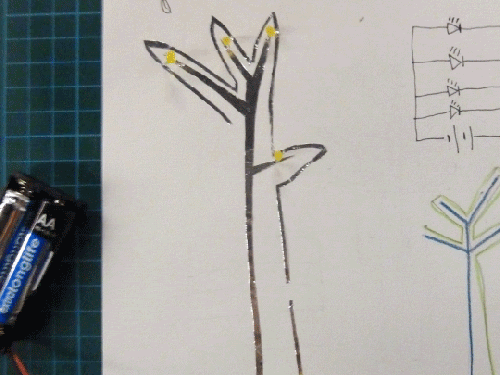Paper Circuits
Paper circuits with kitchen foil: Ooooooh. Now that is low-fi-hi-fi.
Paper circuits with conductive paint: Recently, I had the pleasure of attending an internet of things work day. A team of makers, researchers, academics and artists meet at Bristol University every now and again, and discuss how we can get things to talk to other things to do useful things: the internet of things. It is run by Sarah Eagle, who researches how using digital media affects early years development. She is also organising a mini-maker fair in Bristol on 23rd March.
Aside from the fact that some of the academics spent a rather long time splitting-hairs about what “the internet of things” actually means, and theorising about which type of data would/should/could be communicated, it was great. Our team used conductive paint to make a sonic-paper fortune-teller, that changes frequency according to the strength of the connection.
If you are not so familiar with such a phrase as internet of things, then here is a good talk that explains it nicely, and illustrates useful data transfer between objects (albeit a bit outdated).
Paper circuits with SMA wire: Below you can see some tests that Rosie Wakely and I made with SMA wire, conductive paint, and paper. Whoop. The wire is tricky to use, but I’m slowly getting the hang of it. We also programmed the arduino to make some LEDs blink. Exciting stuff.
Last October we started a club called Fiddle and Flap, which was every thursday afternoon. It’s a space where we got together (with a few other Bristol girl geeks) and made stuff. I am not sure if it will continue, because I’m not in Bristol at the moment, but I’d like to continue making and experimenting in a similar collaborative space.
Paper circuits with more time: Progress in making an automated-paper-pop-up-book has been a bit slower than I’d have liked. I have only managed to meet with the engineer from NASA twice since the Spoon-fed in October, in the past few months both of our schedules have been tres busy, and he lives in the US for 6 months a year, which doesn’t make it any easier to meet up. However, over the next month I’m going to focus more the on the actual pop-up mechanisms, then re-introduce circuits a bit later (as there was waaa-haaay too much information at once. man). More soon.






